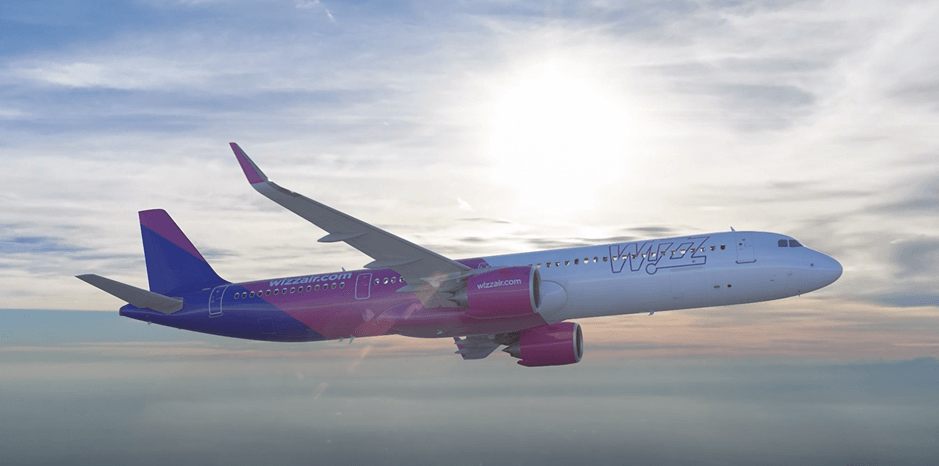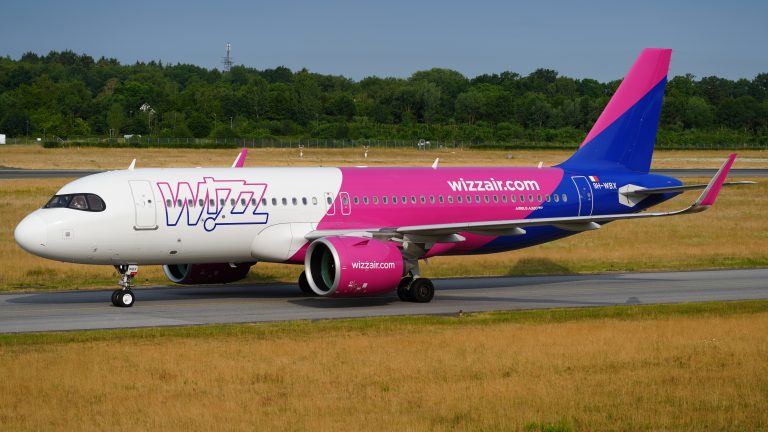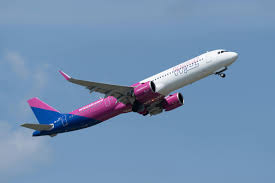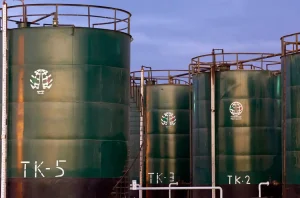Wizz Air Holdings Plc (LON:WIZZ), one of the most sustainable European airlines, has issued unaudited results for the three months to 30 June 2025.
| For the three months ended 30 June | 2025 | 2024 | Change |
| Period-end fleet size 1 | 236 | 218 | 8.3% |
| ASKs (million km) | 32,401 | 29,179 | 11.0% |
| Load factor (%) | 91.1 | 91.0 | 0.0ppt |
| Passengers carried (million) | 17.0 | 15.3 | 10.6% |
| Total revenue (€ million) | 1,428.2 | 1,259.3 | 13.4% |
| EBITDA (€ million)1 | 300.2 | 274.6 | 9.3% |
| EBITDA Margin (%)1 | 21.0 | 21.8 | (0.8)ppt |
| Operating profit for the period (€ million) | 27.5 | 44.6 | (38.3)% |
| Net profit for the period (€ million) | 38.4 | 1.2 | 3109.3% |
| RASK (€ cent) | 4.41 | 4.32 | 2.1% |
| Total CASK (€ cent) | 4.46 | 4.30 | 3.8% |
| Fuel CASK (€ cent) | 1.35 | 1.58 | (14.2)% |
| Ex-fuel CASK (€ cent) | 3.11 | 2.72 | 14.2% |
| Total cash (€ million)2,3 | 1,964.8 | 1,736.0 | 13.2% |
| Net debt (€ million)2,4 | 4,705.4 | 4,956.3 | (5.1)% |
1 Aircraft at end of period includes 3 aircraft in Ukraine, but excludes wet-leased aircraft.
2 For further definition of measures presented refer to “Alternative performance measures (APMs)” section of this document. In addition to marked APMs, other measures presented above incorporate certain non-financial information that management believes is useful when assessing the performance of the Group. For further details refer to “Glossary of terms” section of this document.
3 Comparative figure is total cash balance as at 31 March 2025. Total cash is a non-statutory financial performance measure and comprises cash and cash equivalents (30 June 2025: €1,097.6 million; 31 March 2025: €597.5 million), short-term cash deposits (30 June 2025: €807.7 million; 31 March 2025: 1,060.2) and total current and non-current restricted cash (30 June 2025: €59.5 million; 31 March 2025: €78.3 million).
4 Comparative figure is net debt balance as at 31 March 2025.
HIGHLIGHTS
▶ ASK capacity 11.0 per cent higher in Q1 F26 vs last year.
▶ Carried 17.0 million passengers in Q1 F26 (vs 15.3 million in Q1 F24), with a load factor of 91.1 per cent.
▶ Total unit revenue (RASK) increased by 2.1 per cent to €4.41 cents with ticket RASK up by 2.5 per cent to €2.47 cents and ancillary RASK up by 1.6 per cent to €1.94 cents yoy.
▶ EBITDA increased by 9.3 per cent to €300.2 million, with margin expansion to 21.0 per cent.
▶ Operating profit down to €27.5 million (vs €44.6 million in Q1 F25), impacted by higher airport, handling and en-route charges as well as depreciation costs and GTF engine-related groundings.
▶ Net profit increased to €38.4 million, impacted by unrealised foreign exchange tailwind yoy.
▶ Total cash balance increased by 13.2 per cent vs end of March 2025, to €1,964.8 million and net debt declined by 5.1% per cent to €4,705.4 million, and leverage ratio falling to 4.1x.
▶ GTF engine inspections: 41 aircraft were grounded at the end of June 2025; this compared to 46 parked as at the end of June 2024.
▶ New agreement signed with Pratt & Whitney to select the PW1100G-JM geared turbofan “(GTF”) engine to power Wizz Air’s 177 firm Airbus A321neo aircraft on order alongside long-term maintenance service agreement and ongoing support package to mitigate impact of groundings.
▶ Strategic realignment and focus on core markets announced on 14 July 2025 with suspension of Wizz Air Abu Dhabi operations.
József Váradi, Wizz Air Chief Executive Officer commented:
“We approach F26 with a clear vision of our strategy to focus our business on markets that satisfy two important criteria. Firstly, to ensure we are operating in so called environmentally benign operating environments and secondly, in markets where we already have or will have market share. We believe our core Central and Eastern European (CEE) markets satisfy both these criteria. As such, we have developed initiatives that steer network design to focus on these markets.
We announced the suspension of our Middle Eastern operations from September 1, 2025 onwards and are rationalizing our A321XLR program to ensure we have the right fleet for the network design that delivers the strategy. We are simultaneously pursuing all avenues to lift the fleet that is grounded due to engine supply chain issues and retiring early as many A320 CEO family aircraft as is feasible. This will require further modification to our aircraft delivery schedules to reduce our growth rate to levels that support the demand this revised network will require.
We continue to focus on operational performance with our completion rate back to leadership standards and improvement in on-time performance. Our completion rate was 99.15 per cent and our on time performance rate was 76.35 per cent, which was notably up 8.7 ppts from last year.
This is the result of our continuous investment in technology, staff training and infrastructure enhancements. We successfully operate almost 800 routes in over 50 countries between 33 bases across Europe and the Middle East.
The well documented issues relating to Pratt & Whitney’s GTF engines led to 41 neo aircraft being grounded at the end of the quarter vs 46 aircraft this quarter last year. However, notwithstanding Wizz Air carried 17.0 million passengers over the three months ending June, up 10.6% year-on-year and these results underline the sustained demand for our services across Europe and our ability to offer the best value to our customers.
On current trading and the outlook, Mr Váradi added:
Our management team has demonstrated a high degree of adaptability in recent years when faced by severe challenges, and this year will likely continue to call on that strength as we refocus our business. We see this encompassing some significant changes to our operations but with active execution and a strong balance sheet to support this, I am excited by the long-term prospects for the company.”
Q2 OUTLOOK
The near-term outlook is summarised as follows:
▶ Capacity: Q2 ASKs high single digits YoY
▶ Load factor: Flat (from >2 ppt YoY previously);
▶ Q2 RASK: Flat YoY
▶ Q2 CASK: Fuel CASK: down high-single digits. Ex-fuel unit trends expected to improve vs Q1
GTF ENGINE UPDATE
▶ As of 30 Jun 2025, Wizz Air had 41 aircraft on ground due to GTF engine-related inspections. The average number of grounded aircraft for F26 is estimated to be 35, with this comparing favourably to the 44 average seen in the last fiscal year. (Note: our forecasts remain based on a 300-day engine turnaround time, but future updates should reduce this).
▶ Over and above the tainted metal issue, Wizz Air’s operations have been impacted by the poorer than specified performance of the GTF engine, with a significantly lower time on wing (TOW) before an inspection is required. This has compounded the issue of MRO congestion. As such, Wizz Air is carrying over twice the number of spare engines now than it would normally expect and is contractually obliged to carry.
▶ Positive news on this front is that the selection agreement signed with Pratt & Whitney in May will give Wizz Air access to additional engines so as to accelerate the return to air of the grounded fleet, with this expected now in F27.
FLEET UPDATE
▶ During Q1 F25 Wizz Air took delivery of 10 new A321neo aircraft alongside with 1 new A321XLR aircraft and redelivered 6 A320ceo aircraft, ending the period with a total fleet of 236 aircraft: 31x A320ceo, 41x A321ceo, 6x A320neo, 157x A321neo and 1 A321XLR.
▶ The average age of the fleet currently stands at 4.5 years, the youngest fleet among major European airlines, while the average number of seats per aircraft has climbed to 228 as at June 2025.
▶ The share of new “neo” technology aircraft within Wizz Air’s fleet has increased to 69.5 per cent.
▶ As at 30 June 2025, Wizz Air’s delivery backlog comprises a firm order for 243x A321neo and 46x A321XLR aircraft, a total of 289 aircraft.
FINANCIAL UPDATE
▶ During the quarter Wizz Air continued to apply its jet fuel and foreign currency hedging policy. As of 30 June 2025, Wizz Air has a hedge coverage of 73 per cent for its jet fuel needs for F26 using mostly zero-cost collars and jet fuel swaps at a blended price of 700/773 $/mT. For F27, the coverage is 29 per cent at the price of 661/729 $/mT. The jet fuel-related EUR/USD FX coverage stands at 70 per cent for F26 at 1.09/1.13, while the coverage for F27, stands at 28 per cent at 1.10/1.14 rates.
▶ The Group’s credit rating was downgraded by Moody’s Investor Services on the 17th June 2025 from Ba2 to Ba1 keeping outlook negative given the slower than expected recovery driven by the high level of groundings from the GTF engine issue. Fitch downgraded Wizz Air’s credit rating on 9th July 2025 from BB+ to BB with stable outlook pointing to the weaker operating performance in F25.
▶ The balance of EU emissions trading scheme credits repurchase agreement remains unchanged, at €284.7 million. The inventory must be repurchased from the counterparty by March 2026.
▶ Wizz Air continued to receive OEM compensation from Pratt & Whitney related to the GTF engine issues and it is presented within net other income/(expense) in the consolidated statement of comprehensive income.
ESG UPDATE
▶ Rolling 12-month CO₂ emissions per passenger kilometer declined to 51.7 grams, reflecting a 1.3% year-over-year improvement and marking the lowest level among industry peers.
▶ In April, Wizz Air released Flying Towards Net Zero, its aspirational transition plan focusing on the three pillars of flights, fuel and footprint. This strategy outlines the ambition for decarbonization and calls on stakeholders and regulators to join Wizz Air in ensuring the aviation industry achieves net zero.
▶ Wizz Air was named the world’s most emissions-efficient airline by Cirium Flight Emissions Review ranking.
▶ Wizz Air won the title of Most Sustainable Low-Cost Airline for the fifth consecutive year at the World Finance Sustainability Awards 2025.










































